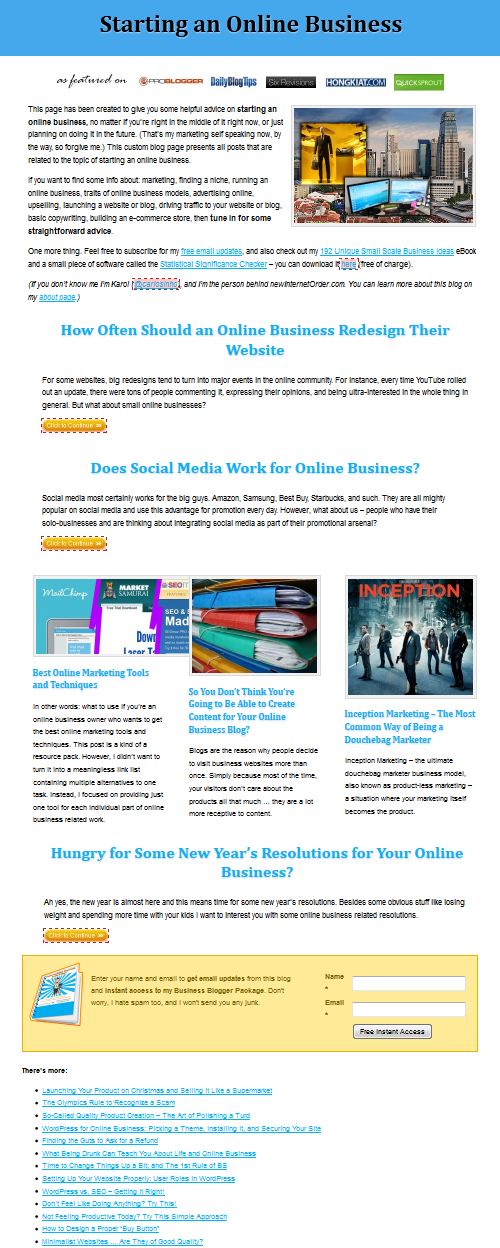Tips that save time.
First of all, I should probably explain why I’m publishing a post talking in detail about some aspect of WordPress as a publishing platform. It’s because landing pages are often one of the main marketing tools for many online businesses, and since WordPress is the most popular website management platform then it all kind of works together…
The keyword there being “kind of.” That’s because landing pages are not a native functionality in WordPress and you have to do a little digging around in order to enable them for your blog business.
By the way, if you take a look in the archives here, you’ll find a post about custom WordPress archive pages, where I offer my archives template (the exact one I’m using on this blog). Don’t forget to check it out.
What is a landing page?
Some time ago, I published a guest post on Six Revisions about good landing page design. If you’re not interested in the design part then just check out the first couple of paragraphs of the article, where I explain the purpose and construction of a standard landing page.
In short, a landing page is a page that your visitors see after clicking on a specific link on another site. For instance, if you advertise your site through AdWords then the URL you link the ad to becomes the landing page.
The purpose of a landing page is to convince the visitor to take a specific kind of action. Usually, it’s to buy something or to subscribe to your mailing list.
Landing pages have been online for a long time now, and for a very simple reason – they work. You are always more likely to succeed if you try to sell a given product through a landing page rather than through a standard blog page.
Now, the exact topic here is SEO landing pages. What differs them from traditional landing pages is that, most importantly, they are meant to rank well in the search engines.
Problems with standard blog pages
The main problem with standard blog pages is that there are too many things that can distract your visitor from taking action, and also too many elements that are not relevant from an SEO point of view.
For example, things like:
- sidebars,
- headers,
- menus,
- Twitter links,
- Twitter and other social media buttons,
- other links to external sites,
- big footers,
- comments, and so on.
Even though these elements are often a must for a blog business in general, they are not that great for landing pages. The main trait of a quality landing page is simplicity.
How to get yourself a nice landing page (the expensive approach)
Here’s the expensive approach of getting yourself a nice landing page (in the next section I’m presenting a free counter-approach).
You can get a nice landing page along with a completely new theme. I know that changing the theme of your site might not sound like the most attractive thing to do, but just hear me out.
Updating your theme to something modern is often the only way to get the possibility to use the newest features in WordPress (which every next version introduces).
The thing I can recommend here is the X Theme. It’s made by a company called Theme Co, and it’s become one of the most popular frameworks for WordPress.
There are many child themes available that offer various landing page templates. For instance, the one called Focus. Here’s what the standard design looks like:

Fairly blog-like designs and layout, right? And here’s what the landing page looks like:

As you can see, there is a big difference. The landing page features no header, no footer, no sidebars, nothing. There’s only the main content block. Even though this might not seem like the most attractive thin visually, it does work business-wise, and can generate a lot better conversions than standard blog pages.
The main benefit of opting for this method is that it requires no effort to create new landing pages … you pay money, but you save time.
How to get yourself a nice landing page (the free approach)
This approach won’t cost you a penny, but it will require some work (you can always ask someone for help if needed).
I want to give you my landing page template. It’s the one I’m using here, and here (image below).

As you can see, there’s a handful of different elements it features:
- the headline,
- the main content block,
- a list of related posts; displayed as (1) excerpts, then as (2) excerpts + images, then as (3) excerpts again, then as (4) standard text links; this is meant to introduce some variety instead of showcasing a long list of links,
- an email subscription block.
The reason why there’s so much content is to make the page relevant to the keyword you’re targeting with it.
To make the landing page work for your current theme, you have to take the code I’m providing below and create a custom page template with it. (The code includes a number of hints to make the integration process easier.)
The template uses one custom field to display a list of related posts (for SEO). The field is called custom_field_tags, it stores the post tags that correspond to the landing page.
For instance, if you want to display all posts tagged with “blogging” then simply set the custom field (when editing your landing page in the WP admin panel) to “blogging” (image below).

If you don’t want to display any related posts then don’t set the custom field.
This is actually it. Once you create a custom page template featuring the code I’m providing here, you can launch new SEO landing pages with ease. Of course, it’s still up to you to make the content optimized, but I hope that this template will make things easier for you on the technical side.
Download here.
Do you plan on launching any SEO landing pages on your online business blog in the near future?



